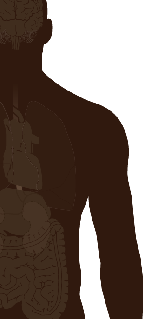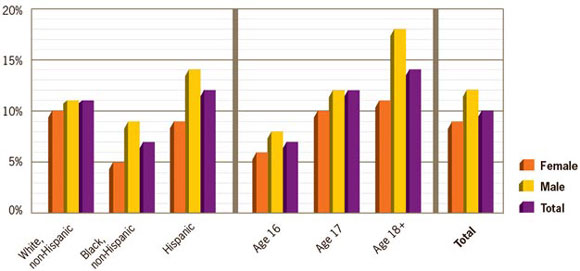Vital Signs: Teen Drinking and Driving
A Dangerous Mix
October 2012



54%
The percentage of teens in high school who drink and drive has decreased by more than half since 1991.

1 in 10
One in 10 teens in high school drinks and drives.*

17x
Young drivers (ages 16-20) are 17 times more likely to die in a crash when they have a blood alcohol concentration of .08% than when they have not been drinking.
The percentage of teens in high school who drink and drive has decreased by more than half since 1991,* but more can be done. Nearly one million high school teens drank alcohol and got behind the wheel in 2011. Teen drivers are 3 times more likely than more experienced drivers to be in a fatal crash. Drinking any alcohol greatly increases this risk for teens.
Research has shown that factors that help to keep teens safe include parental involvement, minimum legal drinking age and zero tolerance laws, and graduated driver licensing systems. These proven steps can protect the lives of more young drivers and everyone who shares the road with them.
*High school students aged 16 years and older who, when surveyed, said they had driven a vehicle one or more times during the past 30 days when they had been drinking alcohol.
Drinking and driving can be deadly, especially for teens
Fewer teens are drinking and driving, but this risky behavior is still a major threat.
- Drinking and driving among teens in high school has gone down by 54% since 1991. Still, high school teens drive after drinking about 2.4 million times a month.
- 85% of teens in high school who report drinking and driving in the past month also say they binge drank. In the survey, binge drinking was defined as having 5 or more alcoholic drinks within a couple of hours.
- 1 in 5 teen drivers involved in fatal crashes had some alcohol in their system in 2010. Most of these drivers (81%) had BACs* higher than the legal limit for adults.
*Blood alcohol concentration. It is illegal for adults to drive with a BAC of .08% or higher. It is illegal for anyone under age 21 to drive after drinking any alcohol in all US states.
Preventing Teen Drinking and Driving: What Works
- Minimum legal drinking age (MLDA) laws in every state make it illegal to sell alcohol to anyone under age 21. Research has shown that enforcement of MLDA laws using alcohol retailer compliance checks has reduced retail sales of alcohol to those under the legal drinking age.
- Zero tolerance laws in every state make it illegal for those under age 21 to drive after drinking any alcohol. Research has demonstrated that these laws have reduced drinking and driving crashes involving teens.
- Graduated driver licensing (GDL) systems help new drivers get more experience under less risky conditions. As teens move through stages, they gain privileges, such as driving at night or driving with passengers. Every state has GDL, but the specific rules vary. Research indicates that GDL systems prevent crashes and save lives.
- Parental involvement, with a focus on monitoring and restricting what new drivers are allowed to do, helps keep new drivers safe as they learn to drive. Parents can consider creating and signing a parent-teen driving agreement with their teens. Research has shown that when parents establish and enforce the “rules of the road”, new drivers report lower rates of risky driving, traffic violations, and crashes.
The percentage of teens in high school, aged 16 years or older, who drink and drive has decreased by more than half.

Source: Youth Risk Behavior Surveys, United States, 1991-2011
Some teens in high school drink and drive more than others.

SOURCE: Youth Risk Behavior Survey, United States, 2011
Percentage of teens in high school, aged 16 years or older, who reported drinking and driving, by state.

SOURCE: Youth Risk Behavior Surveys, 41 states, 2011 Data not available for CA, HI, ME, MN, MO, NV, OR, PA, and WA.
States and communities can
- Increase awareness among teens and parents.
- Strengthen enforcement of existing policies, such as minimum legal drinking age and zero tolerance laws, and graduated driver licensing systems.
Pediatricians and other health professionals can
- Screen teens for risky behaviors, including the following:
- Using alcohol, drugs or other substances
- Driving after alcohol or drug use
- Riding with a driver who has been using alcohol or drugs
- Educate parents and teens about the risks of drinking and driving.
- Encourage parents of new teen drivers to set and enforce the “rules of the road” and consider tools like parent-teen driving agreements.
- Remind parents to lead by example as safe drivers, starting even before their child is old enough to drive.
Teens can
- Choose to never drink and drive.
- Refuse to ride in a car with a teen driver who has been drinking.
- Know and follow their state’s GDL laws.
- Follow “rules of the road” in their parent-teen driving agreement.
- Wear a seat belt on every trip, no matter how short.
- Obey speed limits.
- Never use a cell phone or text while driving.
Parents can
- Understand that most teens who drink do so to get drunk.
- Recognize the dangers of teen drinking and driving and that teen drivers are at much greater risk of crashing after drinking alcohol than adult drivers.
- Provide teens with a safe way to get home (such as picking them up or paying for a cab) if their driver has been drinking.
- Model safe driving behavior.
- Consider tools like parent-teen driving agreements to set and enforce the “rules of the road” for new drivers. Safe driving habits for teens include the following:
- Never drink and drive
- Follow state GDL laws
- Wear a seat belt on every trip
- Limit nighttime driving
- Set a limit on the number of teen passengers
- Never use a cell phone or text while driving
- Obey speed limits
- Vital Signs Issue: Drinking and Driving Among High School Students Aged ≥16 Years — United States, 1991-2011. Morbidity and Mortality Weekly Report (MMWR)
- Teen Drinking and Driving – What You Need to Know [PODCAST – 1:15 minutes]
- (Spanish) Teen Drinking and Driving – What You Need to Know [PODCAST – 1:15 minutes]
- Teen Drinking and Driving – What You Need to Know [PSA – 0:60 seconds]
- Are you hankering for a cup of health? [PODCAST – 5:18 seconds]
- Only have a minute? [PODCAST – 0:59 seconds]
- Impaired Driving
- Teen Drivers
- VitalSigns: Drinking and Driving: A Threat to Everyone
- Parents Are the Key to Safe Teen Drivers
